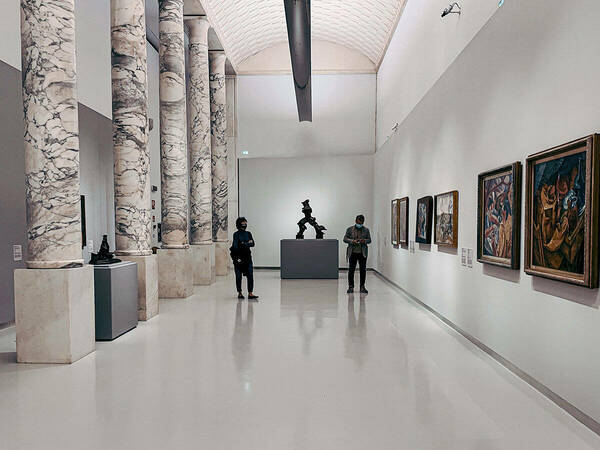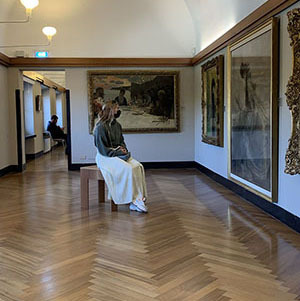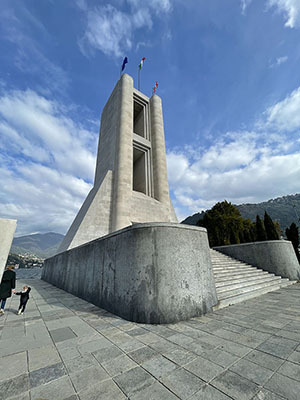
Sophie Kressler ’22 received a Fall Break 2021 Research Grant from the Nanovic Institute for European Studies to conduct research in Italy for her senior thesis on Italian Futurist art and architecture. As part of her art history major, Sophie’s project examines this highly experimental early twentieth-century movement, one that emerged during a period convulsed by dramatic technological developments, social upheaval, and global war. She wrote the following piece for Nanovic Navigator, reflecting on her time in Italy.
Over fall break of the 2021-22 academic year, I traveled to Italy on a Nanovic grant to conduct research as part of my senior thesis project in art history. My thesis focuses on Antonio Sant’Elia (1888-1916) and Italian Futurist architecture in the period of the First World War. I argue that this rather unexamined movement, which celebrated the pace and urgency of the new modern city, played an important role in helping to catalyze the historical avant-garde, the series of artistic movements that defined the early twentieth century.
Within Italy, I traveled to Milan, which functioned as the headquarters of the movement during its earlier phase, and then about 30 miles north to Sant’Elia’s birthplace of Como. The goal of this research trip was to gather a better understanding of the movement as a whole, to take in the built environment of where Sant’Elia and the other artists lived and worked, and to view as many of his drawings as possible, which are not available online and can only be seen in person.

During my week abroad, I visited Milan’s Museo del Novecento, Villa Necchi Campiglio, Galleria d’Arte Moderna, the Duomo and Duomo museum, and Pinacoteca Brera, as well as the Duomo and Pinacoteca Civica in Como. The Museo del Novecento, Galleria d’Arte Moderna, and Pinacoteca Brera all provided me with more examples of Futurist painting, sculpture, fashion, and literature. The Museo del Novecento, in particular, had an entire floor dedicated to the movement and featured several of their manifestos, or expressions of their founding doctrine. Futurism was the first of the avant-garde movements to use the manifesto in this way, and this practice became the norm for artistic and creative movements throughout the twentieth century. Manifestos came in the form of written documents that laid out the rules or guidelines of a specific practice for that movement. In the case of Futurism, examples include Sant’Elia’s Manifesto of Futurist Architecture (1914) or Umberto Boccioni’s Futurist Painting: Technical Manifesto (1910).
Many of Sant’Elia’s architectural plans never came to fruition, in part because he tragically died fighting for Italy during World War I. But, we can still visit great examples of modernist architecture that were realized and were influenced by Sant’Elia’s style. These include Villa Necchi in Milan, which I was able to enter and where I gained a better understanding of the way Italians built and lived at that time.

The Pinacoteca Civica in Como was by far the most useful resource of my research trip. With two large rooms dedicated solely to Sant’Elia’s life and practice, I was able to see all of his drawings and projects while also deepening my knowledge of him as a person. His design for the new Milan terminal was particularly fascinating. It included an underground train station and a runway for airplanes at the ground level, with funicular trains (a type of cable-operated system) connecting the two. Passenger air travel had only just begun, but Sant’Elia was already able to see that it was the way of the future.
If I could offer any advice to students considering a research trip abroad, it would be to take the time to explore where you are and immerse yourself in the culture as much as possible. Some of the more memorable and fascinating discoveries of my visit happened as I was exploring during my down time. In Como, I came across an interesting monument to Italian soldiers who, like Sant’Elia himself, had fallen in World War I. I later discovered that the monument was inspired by his vision for the new modern city and adapted from some of his drawings before the war. If I had not taken that time to do some exploration outside of my research, I would have missed this opportunity to see a rare, and poignant, realization of Sant’Elia’s avant-garde vision.
Originally published by at nanovicnavigator.nd.edu on December 09, 2021. Nanovic Navigator is the platform for stories told by students about their experiences exploring Europe and European studies through the support of the Nanovic Institute.